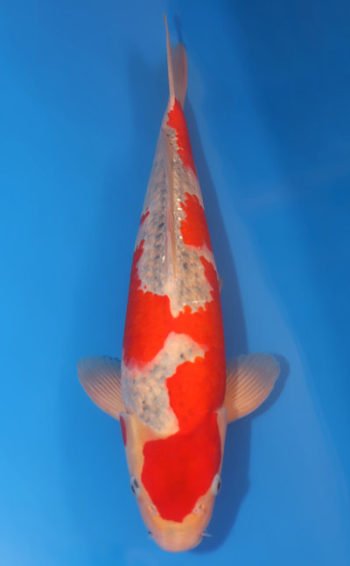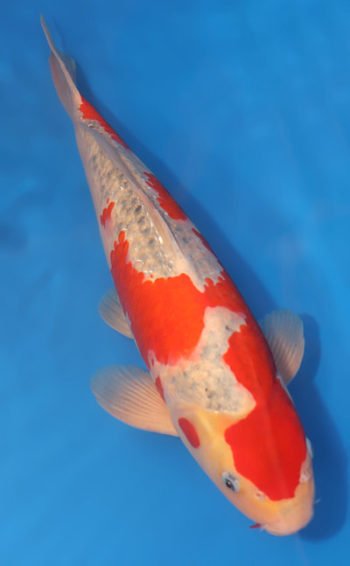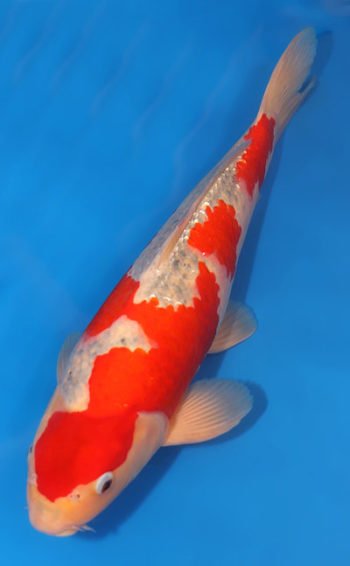Goshiki Koi Coe Fish
See all of our high-quality koi fish for sale & butterfly koi fish for sale. We offer the very best selection of koi for sale in the industry. Put that alongside of our incredible 14-Day Live Arrival Guarantee, and the ability to choose your own delivery date and you have an unbeatable value.
14-DAY WORRY-FREE GUARANTEE: We offer an industry-leading 14-Day Worry-Free Guarantee to ensure that you can shop with peace of mind, knowing that you will always be covered.
Breeder(s): Arowana Paradise Farm
Sex: Male
Size: 18.5 inch
Variety: Goshiki
Original price was: $160.00.$150.00Current price is: $150.00.
Description
Goshiki Koi Coe Fish For Sale
Goshiki Koi Coe Fish, Goshiki pronounced (gosh-key or Go-she-key by some) are an interesting breed of Koi. The name means ‘five colors” in Japanese, but frankly it is not a fitting name in my opinion with today’s Goshiki. You do not readily see five colors at a glance and it is a stretch to do so no matter. This is one breed I feel the Japanese creators misnamed.
Most times the Japanese names are right on the money as for descriptive names that tell a story of what the Koi breed looks like. The name was probably created because of the look of some of the first Goshiki created when they crossed a Sanke to and Asagi. Today however I don’t see the “:five colors) easily. Anyway, enough about that.
The Goshiki basically a white based Koi that has a fishnet black pattern on top of the white base that covers the entire back and runs from the top of the back down to the lateral line (center line of the side of the fish that runs from gill plate to tail base). On top of the fishnet pattern there is a red or orange pattern similar to the Kohaku. This pattern is called the Hi (hee) plate.
Coy fish – Coe fish
One difference in this Hi plate from Goshiki to Kohaku is that the Goshiki Hi tends to be much thicker, bolder and more neon in color intensity as compared to the Kohaku Hi plate which can be a glossy red/orange but not neon. The Goshiki Hi plate actually glows and gives the impression of thickness to the point that the Hi plate can look like a sticker stuck on top of the fishes fishnet pattern.
A good Goshiki should have a clean fishnet pattern with no specs or black spots thrown in to disrupt the fishnet look. The neon red or orange as described above should be thick, and have good clean and crisp edges to the Hi plate. You don’t want to see any holes in that hi plate, but it is ok at times that the black fishnet pattern show through the Hi plate. This is dependent on the age of the fish as to whether it is a detriment or not.
As they mature the Hi plate should and usually does thicken with time, and the fishnet pattern will no longer show thru. The degree of thickening of the Hi plate is a distinctive trait of the Goshiki. However, in all this, the Goshiki can be a very unstable fish when speaking of color development. It is not uncommon that many Goshiki end up losing that hi plat all together. If that happens you are left with quite an ugly fish. The risks however are worth the reward if they develop properly. They are simply stunning to see!
What to Look For When Selecting a Gin Rin Koi
When searching for a good Gin Rin koi you need to look past all the bling, if that’s possible, and pick a fish that is as close to perfect in every other dimension. First, check out the koi’s body conformation. See that it has correct proportions and all fins are intact. Next, watch how it swims, breathes, and reacts to other koi. Then pick out the fish with the most pleasing pattern or colors that you like.
Finally you can concentrate on the Gin Rin scales. Remember that a Gin Rin Koi should have two or more complete rows of scales, the more the better. They should start at the shoulder and end at the tail. Look for scales that are neatly organized in straight and even rows. Avoid those with missing, random or jumbled scales. The layout or placement of scales will not change as your new pet grows. And lastly, choose the koi with the best sparkle as Kin Gin Rin koi are also judged on the quality of their scales.
Koi Care Guide – Six things to know about your koi
- Experience Level: Intermediate
- Size: Koi grow up to 36 inches (91 cm) long
- Lifespan: They can live for more than 50 years and thrive in a wide range of water temperatures
- Temperament: They are generally peaceful but may pick on slower fish
- Origin: They’re a type of carp native to Japan
- Did You Know: Koi can learn to recognize and take food from their pet parents
How do I set up my koi’s aquarium?
- Koi grow quickly and get very large. Keep mature koi in an outdoor pond of at least 3 feet deep, with at least 50 gallons of water per fish.
- Young koi can be kept indoors in an aquarium of at least 29 gallons.
- Put the aquarium in a quiet area out of direct sunlight and drafts.
- Cover the aquarium with a hood to reduce evaporation and splashing and to keep fish from leaping out.
- To transfer new koi to the aquarium, float them in the water inside their bag for about 10 minutes so they can acclimate to the new water temperature.
- If you’re introducing koi to an existing school in an aquarium or pond, quarantine the new fish in a separate body of water for 2 to 4 weeks to be sure they are healthy.
- On moving day, use a net to transfer the koi so old water doesn’t mingle with new water.
- Whether they live indoors or outdoors, add no more than 3 new koi at a time.
Heat & light
Outdoor koi are hardy and will hibernate under ice in winter as long as their pond is deep enough to not freeze completely. (They won’t survive in solid ice.)
Your koi’s pond should be partially shaded.
Indoor koi prefer water between 65 and 75 degrees Fahrenheit.
Install a light inside an indoor aquarium to illuminate it for 8 to 12 hours a day.
Water temperature
Koi are pretty temperature-resistant— they can even hibernate under ice in winter. Just be sure your pond is at least three feet deep— otherwise, it could freeze solid, and koi aren’t that tough. When they live indoors, koi prefer cool water—between 65 and 75 degrees F (18 to 24 C).
How do I keep my koi healthy?
If your outdoor koi don’t seem to be eating in the winter, don’t worry; it’s normal for them to stop eating at temperatures below 40 F. Be sure to contact a veterinarian if you notice any of these symptoms:
- Unusual swimming pattern
- Thinness or decreased appetite
- Abdominal swelling
- Inflamed or discolored skin or fins
- Fins clamped to sides of body
- Scraping body on rocks (flashing)
types of koi fish, koi fish, koi fish price, koi fish pond, koi fish meaning, koi fish for sale, koi fish drawing, koi fish care, koi fish for sale online, butterfly koi for sale, koi fish for sale near me, big koi for sale, buy koi fish cheap, koi fry for sale usa, types of koi fish, koi fish for sale, High Quality Koi, Coy fish, coe fish, goshiki koi for sale, goshiki koi development, goshiki koi champion, asagi koi, goshiki koi fish for sale, baby goshiki koi, kujaku koi, goromo koi





Reviews
There are no reviews yet.